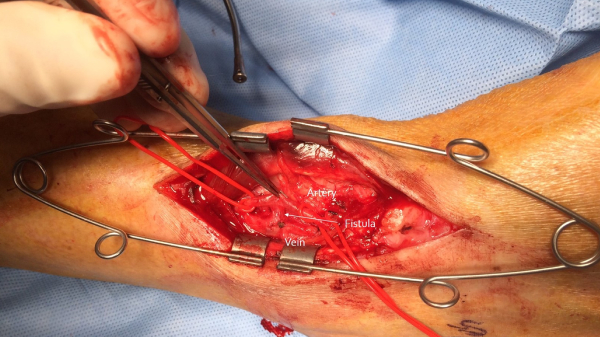Arteriovenous Fistula Surgery
- Home
- /
- Arteriovenous Fistula Surgery

Arteriovenous Fistula Surgery
Dr. Soham, a skilled vascular surgeon, specializes in the treatment of arteriovenous fistula (AVF), a condition where an abnormal connection forms between an artery and a vein. This connection bypasses the capillaries, disrupting the normal blood flow, which can lead to serious complications. AVFs can occur due to congenital defects, trauma, or as a result of medical procedures. They are most commonly associated with dialysis patients who require vascular access for hemodialysis.
Causes and Symptoms of AVF: An arteriovenous fistula may develop due to trauma, surgical procedures, or as a complication from conditions like vascular disease. In some cases, AVFs are congenital (present at birth). Symptoms can include:
Swelling and a noticeable lump in the affected area.
Pulsatile mass or a “thrill” (a vibrating sensation) felt upon touching the area.
Pain or discomfort near the fistula site.
Reduced blood flow in the surrounding veins.
Diagnosis: Dr. Soham would use diagnostic techniques such as Doppler ultrasound or angiography to confirm the presence of an AVF. These imaging tools allow for precise assessment of the abnormal connection and any associated blood flow issues.
Surgical Treatment: The primary treatment for an arteriovenous fistula is surgical repair. During the procedure, Dr. Soham would carefully remove the abnormal connection between the artery and vein. In some cases, a more complex surgery may be required to reconstruct the affected blood vessels and restore normal blood flow. This surgery is typically performed under general anesthesia and may involve stitches or clips to close the fistula.
After the surgery, patients may require follow-up care, including post-operative imaging to ensure the fistula does not recur. The recovery time varies, but most patients can return to regular activities within a few weeks, depending on the extent of the surgery.
For dialysis patients, Dr. Soham may also consider the creation of a functional vascular access point for future dialysis treatments if necessary. This helps in maintaining proper treatment for kidney failure.


